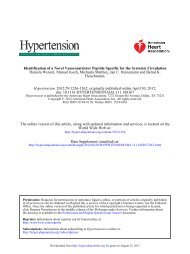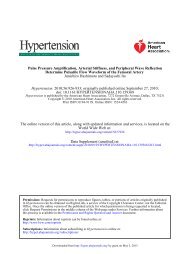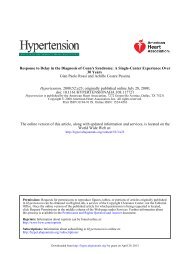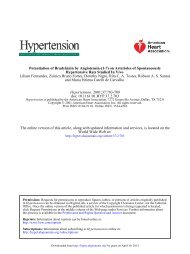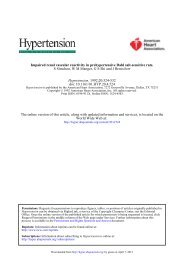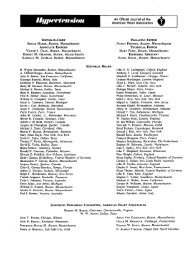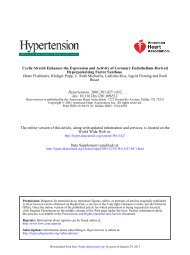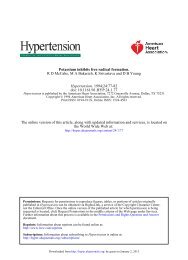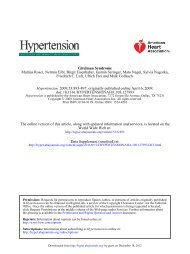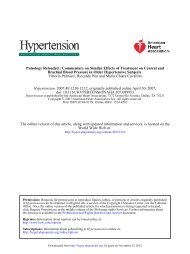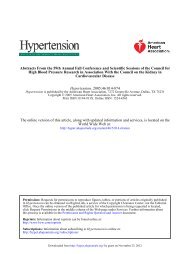Letter to the Editor - Hypertension
Letter to the Editor - Hypertension
Letter to the Editor - Hypertension
Create successful ePaper yourself
Turn your PDF publications into a flip-book with our unique Google optimized e-Paper software.
Response <strong>to</strong> Role of Angiotensinogen and Relative Aldosterone Excess in Salt-Sensitive<br />
<strong>Hypertension</strong><br />
Angela J. Woodiwiss and Gavin R. Nor<strong>to</strong>n<br />
<strong>Hypertension</strong>. 2012;59:e58; originally published online April 30, 2012;<br />
doi: 10.1161/HYPERTENSIONAHA.112.195560<br />
<strong>Hypertension</strong> is published by <strong>the</strong> American Heart Association, 7272 Greenville Avenue, Dallas, TX 75231<br />
Copyright © 2012 American Heart Association, Inc. All rights reserved.<br />
Print ISSN: 0194-911X. Online ISSN: 1524-4563<br />
The online version of this article, along with updated information and services, is located on <strong>the</strong><br />
World Wide Web at:<br />
http://hyper.ahajournals.org/content/59/6/e58<br />
Permissions: Requests for permissions <strong>to</strong> reproduce figures, tables, or portions of articles originally published<br />
in <strong>Hypertension</strong> can be obtained via RightsLink, a service of <strong>the</strong> Copyright Clearance Center, not <strong>the</strong> Edi<strong>to</strong>rial<br />
Office. Once <strong>the</strong> online version of <strong>the</strong> published article for which permission is being requested is located,<br />
click Request Permissions in <strong>the</strong> middle column of <strong>the</strong> Web page under Services. Fur<strong>the</strong>r information about<br />
this process is available in <strong>the</strong> Permissions and Rights Question and Answer document.<br />
Reprints: Information about reprints can be found online at:<br />
http://www.lww.com/reprints<br />
Subscriptions: Information about subscribing <strong>to</strong> <strong>Hypertension</strong> is online at:<br />
http://hyper.ahajournals.org//subscriptions/<br />
Downloaded from http://hyper.ahajournals.org/ by guest on August 30, 2013
<strong>Letter</strong> <strong>to</strong> <strong>the</strong> Edi<strong>to</strong>r<br />
<strong>Letter</strong>s <strong>to</strong> <strong>the</strong> Edi<strong>to</strong>r will be published, if suitable, as space permits. They should not exceed 1000 words<br />
(typed double-spaced) in length and may be subject <strong>to</strong> editing or abridgment.<br />
Response <strong>to</strong> Role of Angiotensinogen and Relative<br />
Aldosterone Excess in Salt-Sensitive <strong>Hypertension</strong><br />
We thank Sa<strong>to</strong>h and colleagues for <strong>the</strong>ir interest in our work<br />
published recently in <strong>Hypertension</strong>. 1 In response <strong>to</strong> <strong>the</strong> <strong>Letter</strong> <strong>to</strong> <strong>the</strong><br />
Edi<strong>to</strong>r by this group, 2 we acknowledge that, as compared with<br />
aldosterone concentrations alone, <strong>the</strong> aldosterone/renin ratio (ARR)<br />
may be more reproducible and, hence, could be used as an index of<br />
inappropriate aldosterone activity. With respect <strong>to</strong> our recent work, 1<br />
fur<strong>the</strong>r analysis did indeed show that plasma angiotensinogen (AGT)<br />
concentrations were related <strong>to</strong> ARR in participants with urinary<br />
Na /K above <strong>the</strong> median (r0.21; P0.0005) but not in those with<br />
urinary Na /K below <strong>the</strong> median (r0.03; P0.52; P0.005 for<br />
comparison of <strong>the</strong> relationships).<br />
Regarding <strong>the</strong> question by Sa<strong>to</strong>h et al 2 on <strong>the</strong> impact of AGT on<br />
ARR-blood pressure (BP) relations, it is important <strong>to</strong> note that this<br />
relationship, as reported previously by us in <strong>the</strong> same community<br />
sample, 3 is driven largely by a negative relationship with plasma<br />
renin. Indeed, only a modest positive relationship between serum<br />
aldosterone concentrations and BP was evident. 3 In contrast, however,<br />
as also reported previously by our group, 3 <strong>the</strong> relationship of<br />
<strong>the</strong> interaction between ARR with urinary Na /K and BP is driven<br />
largely by serum aldosterone and not plasma renin concentrations. 3<br />
We have, <strong>the</strong>refore, emphasized previously that, in this ethnic group,<br />
one should envisage aldosterone effects on BP as being dependent on<br />
salt intake. 3 Thus, <strong>the</strong> question that Sa<strong>to</strong>h et al 2 may have is whe<strong>the</strong>r<br />
circulating AGT concentrations influence <strong>the</strong> interactive effect noted<br />
between ARR and urinary Na /K as a determinant of BP. This was<br />
indeed <strong>the</strong> case, because this relationship was more marked in those<br />
with AGT concentrations above <strong>the</strong> median (r0.26; P0.0001)<br />
versus those below <strong>the</strong> median (r0.12; P0.01; P0.05 for<br />
comparison of partial r values). This interactive effect translates in<strong>to</strong><br />
higher adjusted mean sys<strong>to</strong>lic BP values in individuals with AGT,<br />
ARR, and urinary Na /K above <strong>the</strong> median.<br />
With reference <strong>to</strong> <strong>the</strong> question by Sa<strong>to</strong> et al 2 of whe<strong>the</strong>r ARR is<br />
associated with BP dipping, although we do indeed have ambula<strong>to</strong>ry<br />
BP data on some of <strong>the</strong> participants in our study, not all of those with<br />
high-quality ambula<strong>to</strong>ry BP data have high-quality urine for evaluation<br />
of urinary Na /K , as well as plasma AGT concentrations.<br />
Hence, we are not statistically powered <strong>to</strong> assess <strong>the</strong> impact of AGT<br />
on nondipping.<br />
In conclusion, we believe that our study 1 provides evidence <strong>to</strong><br />
suggest that, in <strong>the</strong> absence of primary aldosteronism, AGT is an<br />
important determinant of renin-angiotensin-aldosterone system activation<br />
and BP, under <strong>the</strong> condition of high-Na , low-K diets and<br />
subsequent renin suppression.<br />
Sources of Funding<br />
Medical Research Council of South Africa, <strong>the</strong> Circula<strong>to</strong>ry Disorders<br />
Research Trust, <strong>the</strong> <strong>Hypertension</strong> Society of Sou<strong>the</strong>rn Africa, <strong>the</strong><br />
University Research Council of <strong>the</strong> University of <strong>the</strong> Witwatersrand,<br />
<strong>the</strong> National Research Foundation of South Africa, and <strong>the</strong> Carnegie<br />
Corporation.<br />
None.<br />
Disclosures<br />
Angela J. Woodiwiss<br />
Gavin R. Nor<strong>to</strong>n<br />
Cardiovascular Pathophysiology and Genomics Research Unit<br />
School of Physiology<br />
University of <strong>the</strong> Witwatersrand<br />
Johannesburg, South Africa<br />
1. Michel FS, Nor<strong>to</strong>n GR, Majane OH, Badenhorst M, Vengethasamy L,<br />
Paiker J, Maseko MJ, Sareli P, Woodiwiss AJ. Contribution of circulating<br />
angiotensinogen concentrations <strong>to</strong> variations in aldosterone and blood pressure<br />
in a group of African ancestry depends on salt intake. <strong>Hypertension</strong>. 2012;59:<br />
62–69.<br />
2. Sa<strong>to</strong>h M, Kikuya M, Ohkubo T, Imai Y. Role of angiotensinogen and<br />
relative aldosterone excess in salt-sensitive hypertension. <strong>Hypertension</strong>.<br />
2012;59:e57.<br />
3. Scott L, Woodiwiss AJ, Maseko MJ, Veliotes DGA, Majane OHI, Paiker<br />
J, Sareli P, Nor<strong>to</strong>n GR. Aldosterone-<strong>to</strong>-renin ratio and <strong>the</strong> relationship<br />
between urinary salt excretion and blood pressure in a community of<br />
African ancestry. Am J Hypertens. 2011;24:951–957.<br />
(<strong>Hypertension</strong>. 2012;59:e58.)<br />
© 2012 American Heart Association, Inc.<br />
<strong>Hypertension</strong> is available at http://hyper.ahajournals.org<br />
DOI: 10.1161/HYPERTENSIONAHA.112.195560<br />
Downloaded from http://hyper.ahajournals.org/ e58 by guest on August 30, 2013



